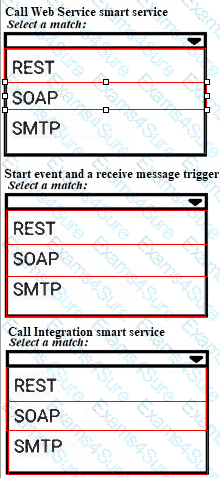
Appian Senior Developer
Last Update 3 days ago
Total Questions : 99
Dive into our fully updated and stable ACD201 practice test platform, featuring all the latest Senior Developer exam questions added this week. Our preparation tool is more than just a Appian study aid; it's a strategic advantage.
Our Senior Developer practice questions crafted to reflect the domains and difficulty of the actual exam. The detailed rationales explain the 'why' behind each answer, reinforcing key concepts about ACD201. Use this test to pinpoint which areas you need to focus your study on.
What are three ways to optimize the memory usage of a process model? (Choose three.)
A local variable is reevaluated every time a form loads and you notice subsequent slow performance of the form.
Which two steps could you perform to optimize this? (Choose two.)
You're creating an application which has integrations with multiple systems using different protocols.
Match each process model component or node to the appropriate protocol.
Note: Each protocol will be used once. To change your responses, you may deselect your response by clicking the blank space at the top of the selection list.

You need to connect to an external system using OAuth 2.0: SAML Bearer Assertion Flow authentication type, which requests access to an API on behalf of a signed in user.
This standard has the several steps involved with the SAML Bearer Assertion Flow.
Which two steps should you perform? (Choose two.)
You need to relate two entities, Employee and Skill, in the data structure. You want to adhere to Appian best practices.
Employees can have multiple skills, and a single skill can relate to multiple employees.
What type of relationship do these entities represent, and what is the minimum number of tables required to implement the design?
You need to connect to an external system using OAuth 2.0: SAML Bearer Assertion Flow authentication type, which requests access to an API on of a signed in user.
This standard has several steps involved with the SAML Bearer Assertion Flow.
Which two steps should you perform to connect to the external system? (Choose two.)
You have designed a three-step 'Wizard' form interaction using user input tasks in the process model. The second step of the Wizard must utilize another process model which contains a user input task inside.
Which two methods should be implemented for a seamless Wizard-like interaction for the user? (Choose two.)
Which two items are configured in the Admin Console when you create a web API? (Choose two.)
You're designing a report to show the total number of cases per month grouped by region. A synced record exists for the data source.
Which design pattern is most appropriate in this case?
The synced record type Customer has a one-to-many relationship with the Case record type.
You need to calculate the number of open cases for each customer.
What are two valid methods to accomplish this? (Choose two.)


TESTED 30 Nov 2025
Hi this is Romona Kearns from Holland and I would like to tell you that I passed my exam with the use of exams4sure dumps. I got same questions in my exam that I prepared from your test engine software. I will recommend your site to all my friends for sure.
Our all material is important and it will be handy for you. If you have short time for exam so, we are sure with the use of it you will pass it easily with good marks. If you will not pass so, you could feel free to claim your refund. We will give 100% money back guarantee if our customers will not satisfy with our products.